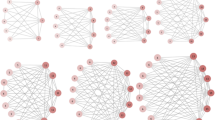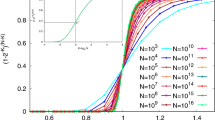Abstract
As is well known, the problem of finding a maximum clique in a graph isNP-hard. Nevertheless, NP-hard problems may have easy instances. This paperproposes a new, global optimization algorithm which tries to exploit favourabledata constellations, focussing on the continuous problem formulation: maximizea quadratic form over the standard simplex. Some general connections of thelatter problem with dynamic principles of evolutionary game theory areestablished. As an immediate consequence, one obtains a procedure whichconsists (a) of an iterative part similar to interior-path methods based on theso-called replicator dynamics; and (b) a routine to escape from inefficient,locally optimal solutions. For the special case of finding a maximum clique ina graph where the quadratic form arises from a regularization of the adjacencematrix, part (b), i.e. escaping from maximal cliques not of maximal size, isaccomplished with block pivoting methods based on (large) independent sets,i.e. cliques of the complementary graph. A simulation study is included whichindicates that the resulting procedure indeed has some merits.
Similar content being viewed by others
References
Bellman, R. (1960), Introduction to Matrix Analysis, McGraw-Hill, New York.
Bollobás, B. (1979), Graph Theory, Springer, New York.
Bomze, I.M. (1983), Lotka–Volterra equation and replicator dynamics: a two-dimensional classification, Biol. Cybern. 48, 201–211.
Bomze, I.M. (1992), Copositivity conditions for global optimality in general quadratic problems, Czechoslovak J. of OR 1, 7–19.
Bomze, I.M. (1996), Block pivoting for detecting copositivity, Linear Algebra Appl.248, Nov. 15.
Bomze, I.M. (1996), Regularization in evolutionary optimization processes of standard QPs, I.S.O.C. Technical Report 96-08, Univ. Vienna.
Bomze, I.M. and Danninger, G. (1994), A finite algorithm for solving general quadratic problems, J. Global Optimiz. 4, 1–16.
Bomze, I.M., Pelillo, M., and Giacomini, R. (1996), Evolutionary approach to the maximum clique problem: empirical evidence on a larger scale. In: I.M. Bomze, T. Csendes, R. Horst, and P.M. Pardalos (eds.), Developments in Global Optimization. Kluwer, Dordrecht.
Bron, C. and Kerbosch, J. (1973), Finding all cliques of an undirected graph, Commun. ACM 16, 575–577.
Cabrales, A. and Sobel, J. (1992), On the limit points of discrete selection dynamics, J. Econ. Theo. 57, 473–504.
Carraghan, R. and Pardalos, P.M. (1990), An exact algorithm for the maximum clique problem, Oper. Res. Lett. 9, 375–382.
Comtet, L. (1974), Advanced Combinatorics, Reidel, Dordrecht.
Crow, J.F. and Kimura, M. (1970), An Introduction to Population Genetics Theory, Harper & Row, New York.
Gibbons, L.E., Hearn, D.W., and Pardalos, P.M. (1996), A continuous-based heuristic for the maximum clique problem. In: D.S. Johnson and M. Trick (eds.), Second DIMACS Implementation Challenge. DIMACS Series inDiscreteMathematics and Theoretical Computer Science, in press.
Gibbons, L.E., Hearn, D.W., Pardalos, P.M., and Ramana, M.V. (1996), Continuous characterization of the maximum clique problem. To appear in Math. Oper. Res.
Hofbauer, J. and Sigmund, K. (1988), The Theory of Evolution and Dynamical Systems, Cambridge University Press.
Horst, R., Pardalos, P.M., and Thoai, N.V. (1995), Introduction to Global Optimization, Kluwer, Dordrecht.
Jagota, A. (1995), Approximating maximum clique with a Hopfield network, IEEE Trans. Neural Networks 6, 724–735.
Losert, V. and Akin, E. (1983), Dynamics of games and genes: discrete versus continuous time, J. Math. Biol. 17, 241–251.
Minc H. (1988), Nonnegative Matrices, Wiley, New York.
Motzkin, T.S. and Straus, E.G. (1965), Maxima for graphs and a new proof of a Theorem of Turán, Canadian J. Math. 17, 533–540.
Mulholland, H. and Smith, C. (1959), An inequality arising in genetical theory, Amer. Math. Monthly 66, 673–683.
Nachbar, J. (1990), “Evolutionary” selection dynamics in games: convergence and limit properties, Int. J. Game Theo. 19, 59–89.
Pardalos, P.M. and Phillips, A.T. (1990), A global optimization approach for solving the maximum clique problem, Int. J. Comp. Math. 33, 209–216.
Pardalos, P.M. and Xue, J. (1994), The maximum clique problem, J. Global Optimiz. 4, 301–328.
Pelillo, M. (1995), Relaxation labeling networks for the maximum clique problem, J. Artif. Neural Networks 2, 313–327.
Pelillo, M. and Jagota, A. (1995), Feasible and infeasible maxima in a quadratic program for maximum clique, J. Artif. Neural Networks 2, 411–419.
Sigmund, K. (1987), Game dynamics, mixed strategies, and gradient systems, Theor. Pop. Biol. 32, 114–126.
Sinclair, A. (1992), Improved bounds for mixing rates of Markov chains and multicommodity flow, Combinatorics, Probability and Computing 1, 351–370.
Sinclair, A. (1993), Algorithms for Random Generating & Counting, Birkhäuser, Boston.
Skiena, S. (1990), Implementing Discrete Mathematics, Addison-Wesley, Redwood City, Calif.
Weibull, J.W. (1995), Evolutionary Game Theory, MIT Press, Cambridge, Mass.
Wolfram, S. (1991), Mathematica, 2nd ed., Addison-Wesley, Redwood City, Calif.
Author information
Authors and Affiliations
Rights and permissions
About this article
Cite this article
Bomze, I.M. Evolution towards the Maximum Clique. Journal of Global Optimization 10, 143–164 (1997). https://doi.org/10.1023/A:1008230200610
Issue Date:
DOI: https://doi.org/10.1023/A:1008230200610




